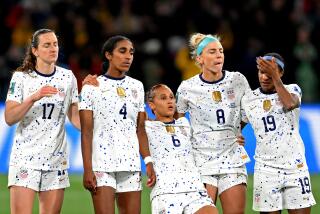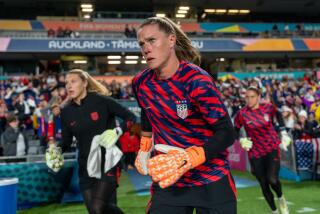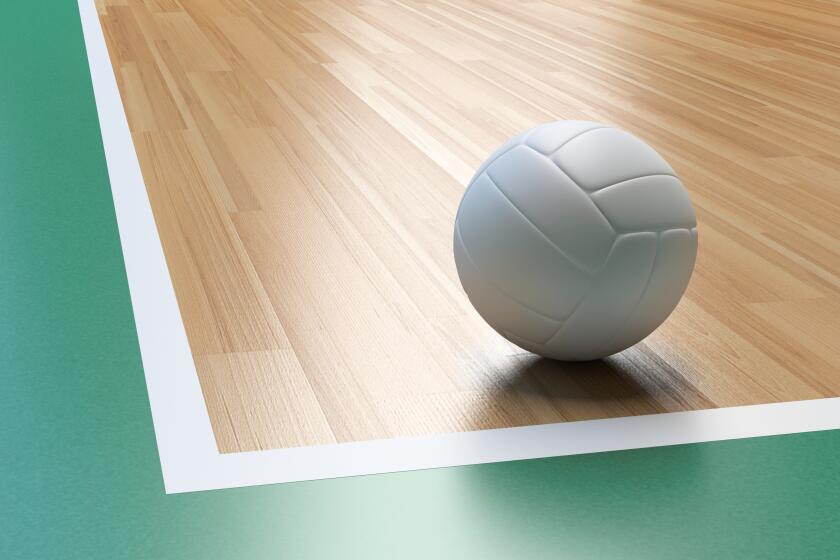Goatborg
GOTEBORG, Sweden — The rampant hubris that so often propels American tennis players to great heights has brought the U.S. Davis Cup team crashing to earth once again.
All of the talent and breeding brimming from the team that assembled two of the best singles players in the world to face a modest and self-effacing group of Swedes--all that crumbled as it so often has.
Sweden took its 2-0 lead, won the doubles Saturday, and clinched its sixth Davis Cup title, 3-0. Today’s two meaningless singles matches can be of no benefit for the U.S., which on Friday lost Pete Sampras to a pulled calf muscle and a dejected Michael Chang to a continued slump.
Jonas Bjorkman and Nicklas Kulti plowed over Todd Martin and Jonathan Stark in front of 11,510 screaming fans at the Scandinavium. The score of 6-4, 6-4, 6-4 was as bleak as the weekend has been for the heavily favored American team.
This is shaping up to be the worst American Davis Cup defeat in the finals since 1984, when the Swedes beat them here, 4-1. Before that, Australia beat the U.S., 5-0, to win the title in 1973.
The doubles is a traditional weakness for the United States in Davis Cup play, and the must-win position was difficult for Martin and Stark.
Stark is an accomplished doubles player--last week he won the ATP World Doubles title with Rick Leach. He is ranked No. 13 in doubles, but he has yet to win a doubles match in Davis Cup.
Martin, on the other hand, has played only two doubles matches this year--one on the tour and one with Sampras in the Davis Cup semifinals in September--and lost both. His doubles ranking is No. 1,277.
American captain Tom Gullikson refused to answer a question about a possible Stark-Leach team.
“It’s very disappointing,” Gullikson said, shivering in a passageway underneath the stadium where American teams have lost three times. “I came here with the idea of exorcising the ghosts of Goteborg past, and we have another nightmare here. It was a nightmare for me. It couldn’t have gone worse.”
The American team has put forth its usual complaints regarding Davis Cup, ranging from scheduling to the length of the season.
While it is true that the 11-month tennis season is overly long, it is equally true that nothing but their own greed compels players to participate in lucrative exhibitions during off weeks.
It is also money, in the form of six-figure guarantees, that sends players to hard-to-get-to tournaments in Qatar and Dubai, then causes them to complain about travel.
Gullikson is correct in noting that players are “banged up” at the end of the long season, but the Swedish players participate in the same season and not one of them is injured or complaining.
In fact, Bjorkman has played more matches than anyone else on the tour and has won more singles and doubles matches this season than any other player. More to the point, Bjorkman has won more singles matches than Sampras has played.
Sampras’ season was abbreviated by chance and choice: He had at least two weeks off, failing to make it to the second week of the French and U.S. Opens, and two more weeks off during the first two rounds of Davis Cup, which he passed on.
One question preying on Gullikson today is the status of Sampras for next year. A season-ending injury is just the sort of catastrophe Sampras predicts when he speaks about the strain of Davis Cup.
Gullikson knows he needs to secure Sampras’ participation if the U.S. hopes to get even close to the final next year. The Americans open at home against Russia, finalists in 1994 and 1995.
“I hope this doesn’t sour his feelings about Davis Cup,” Gullikson said.
The U.S. Tennis Assn. tries to make it sweet for American Davis Cup players, who are paid at least four times as much as other teams. The USTA pays each player $100,000 for singles and $50,000 for doubles, per round. Anyone playing three rounds receives a $100,000 bonus.
When money hasn’t worked, the USTA ups the ante with travel on private jets or the Concorde and bookings in first-class hotel suites.
In the high-stakes world of professional tennis, even financial incentive isn’t enough to lure Americans to Davis Cup, especially this generation of tradition-challenged players.
One problem with the American Davis Cup team is it’s not a team, it’s a loose assemblage of talented players. Gullikson is expected to foster chemistry among a group of players that changes each round. When they do get together for the final, there is a forced quality to the tentative cheering.
Not even a spirited musical jam session in the American locker room before Saturday’s match provided the spark; no amount of caps worn backward can substitute for genuine feelings for your teammates.
“In the end, you have to win the tennis,” Gullikson said. “It’s not just the hype.”
Most teams, like the Swedes, arrive at a Davis Cup site early, practice together and take meals as a group. They appear to like one another.
The Americans act as though they are avoiding noxious in-laws. In a news conference earlier in the week, when Chang spoke of the “camaraderie” developing on the team, even other players snickered. Sampras, who was reported to be so injured he could not put weight on his leg, didn’t make it out of his hotel suite to watch his teammates Saturday.
They are products of their environment. The American sports system--so heavily weighted toward the individual--churns out selfish and creative prima donnas for whom the “team” is viewed as a vehicle for personal aggrandizement.
The Swedes, raised in a quasi-socialist nation with a collective mind-set, easily make the transition from the me-first individualism of the tour to the at-your-service necessity of Davis Cup.
The difference is glaring. The Swedes listen to and take the advice of their captain, Carl-Axel Hageskog. During changeovers he can be seen plotting with and advising his players, who make eye contact and nod.
Gullikson’s role is to stay out of the way of his players’ personal coaches, fetch drink bottles, and pat rear ends. The players would accept no more and seldom bother to acknowledge him during changeovers.
The Swedish players characterized their Davis Cup participation as a “privilege.” It’s more of a pain for their American colleagues.
No tennis players on earth are less accessible than the U.S. Davis Cup team. They travel in a protective bubble that is even more impenetrable when journalists are present. At least there’s a certain democratic element to their snubs: The four American journalists from daily newspapers who traveled to Sweden for the final were just as shut out as the international press.
Not only did members of the Swedish Davis Cup team conduct a three-hour children’s clinic before Saturday’s match, they made their home telephone numbers available to reporters who wished to discuss the national Tennis Future program.
(BEGIN TEXT OF INFOBOX / INFOGRAPHIC)
DAVIS CUP BY THE NUMBERS
59: U.S. appearances in final
31: U.S. victories in final
11: Sweden appearances in final
6-5: Sweden record in final
0-2: U.S. record versus Sweden in final
‘95: Last U.S. victory in final (over Russia)
More to Read
Go beyond the scoreboard
Get the latest on L.A.'s teams in the daily Sports Report newsletter.
You may occasionally receive promotional content from the Los Angeles Times.











